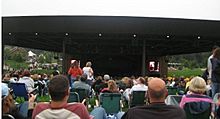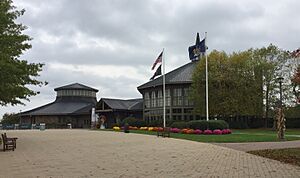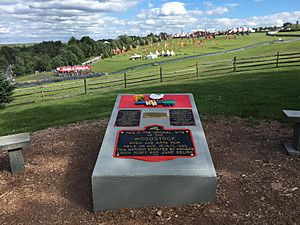Bethel Woods Center for the Arts facts for kids
|
Bethel Woods
|
|
 |
|

View of the pavilion from the lawn prior to a concert
|
|
| Address | 200 Hurd Road |
|---|---|
| Location | Bethel, New York |
| Type | Outdoor amphitheatre |
| Seating type | Reserved, lawn |
| Capacity | 15,000 |
| Construction | |
| Broke ground | 2004 |
| Opened | July 4, 2006 |
| Construction cost | $150 million |
The Bethel Woods Center for the Arts is a special place in Bethel, New York. It's an outdoor concert venue, a performing arts center, and a museum. This center is built on the very same land where the famous 1969 Woodstock Music & Art Fair happened.
Bethel Woods is about 90 miles (145 km) from New York City. The whole area covers about 800 acres (3.2 km²). It has a big outdoor concert stage that can hold 15,000 people. There's also a smaller outdoor stage for 1,000 people. Inside, there's a cozy hall with 440 seats. The Museum at Bethel Woods is also part of the site. Concerts usually take place from June to September, featuring many different kinds of music.
Contents
History of Bethel Woods
How Bethel Woods Started
In 1996, a man named Alan Gerry wanted to help his local area. He lived in Liberty (village), New York, and had started a company called Cablevision Industries. He created a special group called the Gerry Foundation. Its goal was to help the economy of Sullivan County, New York, grow again. The area had faced tough times after many resorts in the Catskill's "Borscht Belt" closed down.
That same year, the Foundation bought the original 37-acre (0.15 km²) field where the Woodstock festival took place. They also bought hundreds of acres around it. Their plan was to build an arts center there.
Early Events and Construction
In 1998, the Foundation held a three-day festival on the site. It was called "Day in the Garden." In 1999, they hosted a four-day party. This celebrated the 30th anniversary of the first Woodstock festival.
Plans for the arts center began in 2002. A company called DLR Group designed it. Construction on the $150 million project started two years later. The big outdoor concert area opened on July 4, 2006. The New York Philharmonic orchestra performed there first. On August 13, 2006, the famous music group Crosby, Stills, Nash & Young played for 16,000 fans. This was 37 years after they performed at the original Woodstock. For their last song, they played "Woodstock."
The Museum and Education
The museum at Bethel Woods opened in June 2008. It teaches visitors about the 1969 Woodstock festival. It also explores the culture of the 1960s.
In 2012, Bethel Woods became its own independent non-profit organization. The next year, a music school opened at the site. This school helps expand music education programs for young people and teenagers.
Places to See at Bethel Woods
Bethel Woods has several different performance areas. The main stage is called The Pavilion. It has a covered area with 4,500 seats. There's also a grassy lawn that slopes down, which can hold up to 10,500 people. The total capacity for the Pavilion is 15,000.
Near the museum, there's an outdoor Terrace Stage. This stage can hold up to 1,000 people. The original Woodstock Festival Field is also available. It can host events for up to 30,000 people.
Other spaces at the center include an indoor Event Gallery with 440 seats. There's also a Museum Theatre with 132 seats. The Market Sheds are used for events, and there are two classrooms.
The Museum at Bethel Woods
What You'll Find at the Museum
The Museum at Bethel Woods opened in June 2006. Its main goal is to show what the 1969 Woodstock Music & Art Fair was like. It also explains why Woodstock was so important. The festival was a big event that showed how much culture changed in the 1960s. The museum also explores the lasting impact of the 1960s and Woodstock.
The museum has permanent exhibits. These include "The Sixties," "The Woodstock Festival," "Three Days of Peace and Music," and "Impact of Woodstock & The Sixties." Each exhibit has films and interactive displays. You can also read text panels and see collections of real items from that time.
Learning About the 1960s
About two-thirds of the museum focuses on the music festival. But it also offers exhibits and personal stories about other parts of the 1960s. You can learn about the music, fashion, and political protests of that time.
The museum helps explain the world Woodstock happened in. It covers topics like the "baby boom" (when many babies were born after World War II). It also talks about the Cold War, the Vietnam War, and the Civil Rights Movement. These events helped shape the 1960s.
The museum is about 7,000 square feet (650 m²). It has a high-definition theater with 132 seats. There's also a gallery that is 4,300 square feet (400 m²). You can find classrooms, a cafe, a museum shop, and an outdoor patio. A special exhibit gallery opened in 2009.
In 2010, the Museum at Bethel Woods received a special award. It was a Thea Award for being excellent in themed entertainment.
Economic Impact of Bethel Woods
Bethel Woods offers programs for nine months of the year. When the center opened, it helped bring tourism back to the area. This was important because many resorts had closed down. Sullivan County had faced challenges after the decline of the "Borscht Belt" tourism.
The opening of the performing arts center in 2006 led to more development. New businesses and homes appeared in Bethel and nearby areas. Bethel Woods is now one of the biggest programs helping the county's economy.
A report from 2018 showed that Bethel Woods has generated over $560 million in spending in New York. Since 2006, about 2.9 million people have visited. In 2018 alone, there were over 214,000 visitors. This activity supports about 172 full-time jobs. Bethel Woods itself pays about $5.1 million in wages in Sullivan County.
See also
- List of contemporary amphitheatres




